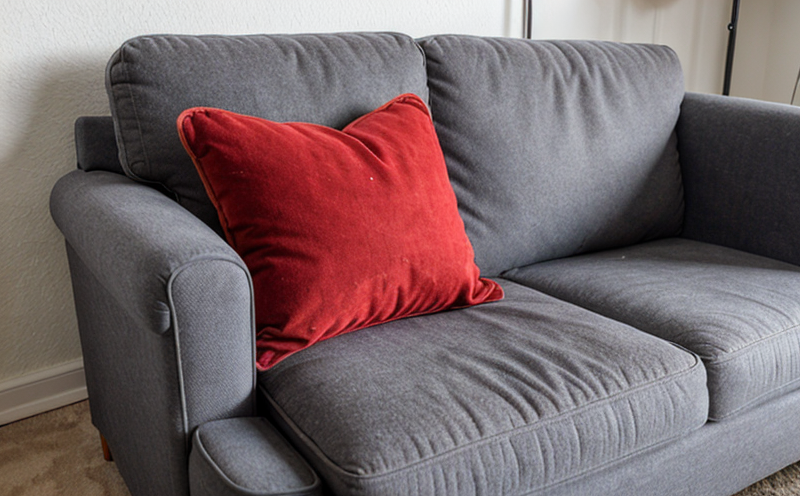BS EN ISO 13938 Bursting Strength of Upholstery Fabrics Testing
The BS EN ISO 13938 standard is pivotal for manufacturers and quality managers in the furniture industry, particularly those involved with upholstery fabrics. This standard provides a robust framework to assess the bursting strength of upholstery fabrics, ensuring that products meet stringent durability requirements.
Upholstery fabrics are subjected to various stresses during their lifecycle, including compression, stretching, and exposure to environmental factors such as humidity and temperature. The bursting strength test evaluates how these materials perform under simulated conditions that mimic real-world stress scenarios. This is crucial for ensuring the longevity of furniture products.
The testing procedure involves subjecting a specimen cut from the upholstery fabric to an increasing pressure until it bursts. The burst load (measured in Newtons) indicates the material's resistance to expansion and rupture under applied stress. A higher burst strength value suggests better performance against wear and tear, enhancing the overall quality of furniture products.
The significance of this test extends beyond ensuring aesthetic appeal; it plays a crucial role in maintaining product integrity and customer satisfaction. By adhering to BS EN ISO 13938 standards, manufacturers can demonstrate compliance with international best practices and gain consumer trust. This testing is especially important for high-end furniture pieces that are designed to endure harsher conditions or higher use.
Understanding the test parameters and specimen preparation is essential for accurate results. Specimens should be cut from the fabric in accordance with specified dimensions, ensuring uniformity across all samples tested. The testing apparatus used must comply with the standard's requirements, which include a burst tester capable of applying controlled pressure to the specimen.
The test setup involves placing a pre-conditioned specimen on the burst tester and gradually increasing the applied pressure until the fabric bursts. The force at which this occurs is recorded as the bursting strength value. This data can then be used by manufacturers to optimize their product design, selecting fabrics that meet or exceed the required standards.
Compliance with BS EN ISO 13938 not only ensures product quality but also provides a competitive edge in the marketplace. It demonstrates a commitment to sustainability and longevity, which are increasingly important factors for consumers. For manufacturers aiming to expand their market reach, compliance can open doors to new opportunities, including international markets that prioritize strict quality control.
Applied Standards
| Standard Reference | Description |
|---|---|
| BS EN ISO 13938-1 | Determination of bursting strength - Part 1: General requirements and test methods for upholstery fabrics. |
| BS EN ISO 13938-2 | Determination of bursting strength - Part 2: Specific applications and additional test methods. |
The BS EN ISO 13938 series provides comprehensive guidelines for the determination of bursting strength in upholstery fabrics. These standards ensure consistent testing practices across different manufacturers, thereby maintaining high-quality benchmarks for the industry.
Industry Applications
The application of BS EN ISO 13938 is widespread within the furniture manufacturing sector. Quality managers and compliance officers rely on this standard to ensure that all upholstery fabrics used in their products meet the required durability standards. This is particularly important for high-end furniture that is designed to withstand extended use or harsh environmental conditions.
R&D engineers benefit from this testing as they can incorporate feedback from these tests into product development, improving both functionality and longevity. For procurement departments, compliance with these standards ensures that the fabrics purchased meet international quality benchmarks, reducing the risk of substandard materials being used in production.
Use Cases and Application Examples
The bursting strength test is crucial for various types of furniture, including office chairs, sofas, armchairs, and recliners. In these applications, the upholstery fabric must be able to withstand significant pressure without failing, ensuring a comfortable and long-lasting seating experience.
For instance, in an office environment, employees may frequently shift their weight or engage in activities that could potentially place stress on the upholstery. Ensuring high bursting strength ensures that these fabrics do not tear or rupture under normal use conditions, maintaining the integrity of the furniture over time.
In home settings, sofas and armchairs are subjected to a range of environmental factors, including humidity and temperature fluctuations. The bursting strength test helps manufacturers select materials that can withstand such variations without compromising on quality or durability.





